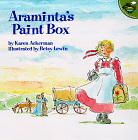A Timeline Activity with Children's Books
by Carol Otis Hurst. This article first appeared in Teaching K-8 Magazine.
Make a large time line from 1620 to 1991, using a large roll of craft paper. Let the kids decide which dates are important enough to be placed on the line. Make them defend their choices and try to keep it from being totally a list of wars. Then fill in non-fiction, novels and picture books to support as many events as possible. They can use book covers for illustrations, or better yet, draw or paint symbols or pictures for each event.
The Books:
For 1620 I nominate Patricia Clapp's Constance: a Story of Early Plymouth (Penguin, 1986 ISBN 0-14-032030-X) for a novel, Marcia Sewall's The Pilgrims of Plymouth (Macmillan, 1986 ISBN 0-689-31250-4,) for non-fiction and picture book since it is both. (Besides, I couldn't find a good fictional picture book about the Pilgrims, can you?).
For the Revolution, I think you can't do better than My Brother Sam Is Dead by James and Christopher Collier (Macmillan, 1974 ISBN0-02-722980-7) for a novel, any of Jean Fritz's Bicentennial biographies, particularly Can't You Make Them Behave, King George? (Putnam, 1982 ISBN 0-698-20542-1) for a work of non-fiction and This Time Tempe Wick? by Patricia Lee Gauch (Putnam, 1974 ISBN 0-698-20300-3) for a picture book and, by the way, isn't there a violation of the Bill of Rights here? Do they have a right to take her horse? Of course, since it's "pre-Bill" here, the debate is moot.

According to my history book, the first covered wagon train set out from the Missouri River set out in 1830 led by William Sublette. That should lead to some discussion since there are so many wagon train stories available in novels and in picture books. Try Araminta's Paint Box by Karen Ackerman for a picture book and Grasshopper Summer by Ann Turner for a novel. Also one of my favorite books A Gathering of Days by Joan Blos (Macmillan, 1982 ISBN 0-684-16340-3) is set in 1830, although it has nothing to do with wagon trains.
The Civil War is easy. My nomination for a picture book about that era goes to George Ella Lyon's Cecil's Story with paintings by Peter Catalanotto (Orchard, 1991 ISBN 0-531-08512-0.) For a novel, I think you still can't beat Across Five Aprils by Irene Hunt, currently out of print. Carolyn Reeder's Shades of Gray (Macmillan, 1989 ISBN 0-02-775810-9) is really about the aftermath of the war so, if you choose to include it, place it in 1866. For non-fiction there's Patricia Lee Gauch's Thunder at Gettysburg (Putnam, 1990 ISBN 0-399-22201-4.)
1898 is the year when there was a violent clash between coal mine owners and union workers in Illinois. That lets us bring in Doreen Rappaport's simple but provocative novel Trouble at the Mines (Harper, 1987 ISBN 0-690-04445-3.) John J. Flagler's The Labor Movement in the United States (Lerner, 1990 ISBN 0-8225-1778-7)is a good non-fiction source of information. Three picture books concern coal mining: Coal Mine Peaches by Michelle Dionetti and illustrated by Anita Riggio (Orchard, 1991 ISBN 0-531-05948-0,) a book about three generations of an Italian family of laborers; In Coal Country by Judith Hendershot (Knopf, 1987 ISBN 0-394-88190-7,) with its wonderfully dusty illustrations and a new book by Lauren Mills The Rag Coat (Little Brown, 1991 ISBN 0-316-57407-4.)
World War I and the Great Depression are not as easy, but you can find them if you look. Try Yoshiko Uchida's A Jar of Dreams (Macmillan, 1985 ISBN 0-689-50210-9) for a Japanese-American look at the depression or Robert Newton Peck's Arly (Walker, 1989 ISBN 0-8027-6856-3) for a visit to a migrant labor camp of the time.
That's just the beginning, of course. You'll want to keep the time line going to the present day, although it's difficult to find historically oriented novels and picture books that are set in periods after the war in Vietnam. The space program may lead you there. Fiction is hard to find but non-fiction abounds.
Don't forget to have some of the children involved in researching events in Black History. When were the first slaves imported? Nat Turner's Revolt? John Brown? The Emancipation Proclamation? The establishment of Civil Rights? This will lead to a wonderful list of readings all along the way. See Martin Luther King Day.
Immigration was occuring throughout our history, obviously, and can lead you into a theme on that subject alone.
Along the way, children may want to list the various presidential terms, and find or draw pictures of the architecture and clothing of the period. Since we want to avoid the perception that events in the rest of the world stood still while the United States surged forward, it might be an interesting side project for some researchers to add a world events timeline to be placed over or under this one.
As always, one good book leads to another and you can stop at almost any point on either time line and do a whole theme or research project where you stand. Activities like these lead children to discover new authors and topics, shaking some of them loose from their diet of horse stories or series books.
Related Areas within Carol Hurst's Children's Literature Site
Advertisement:
Advertisement:
Advertisement:

